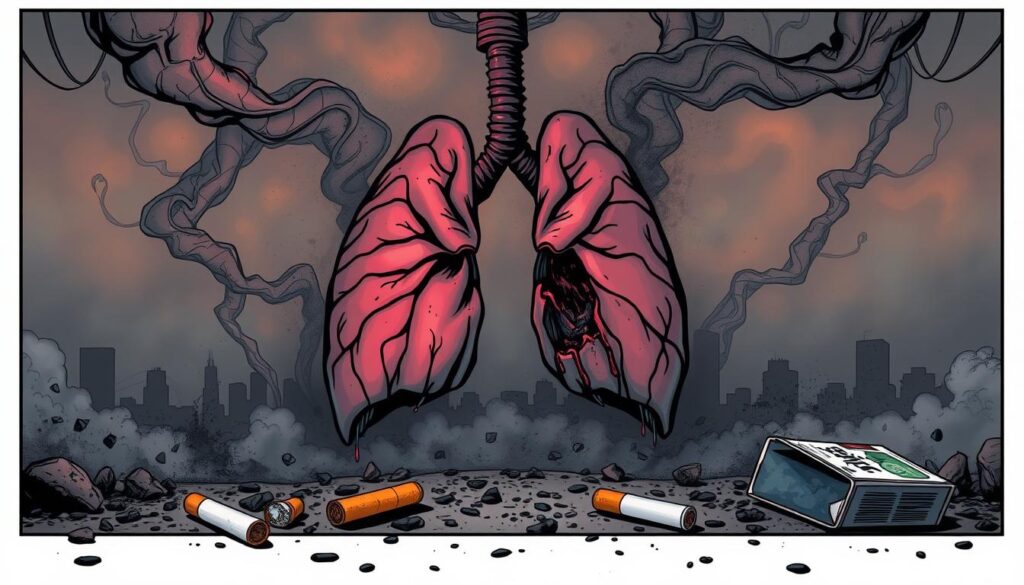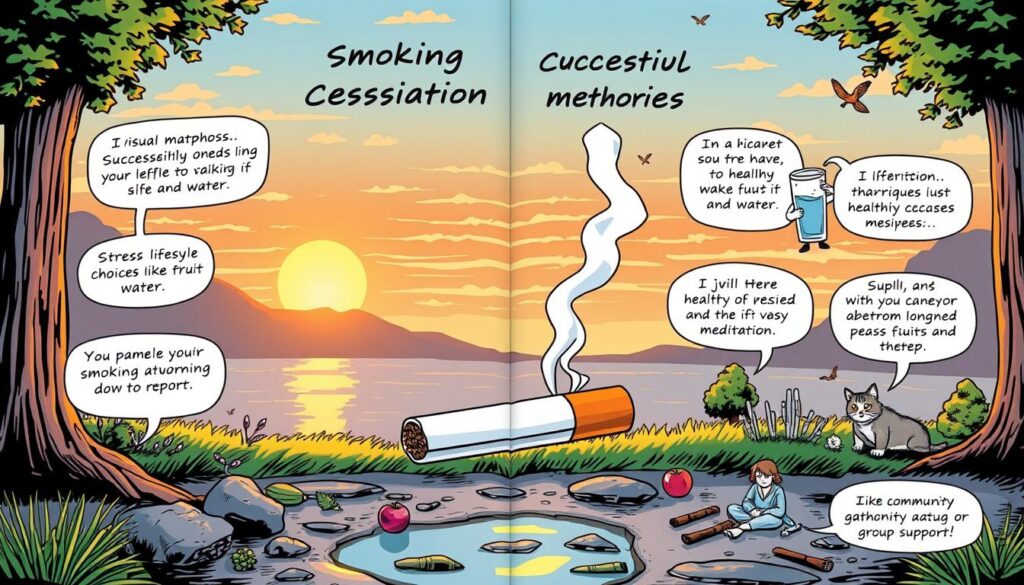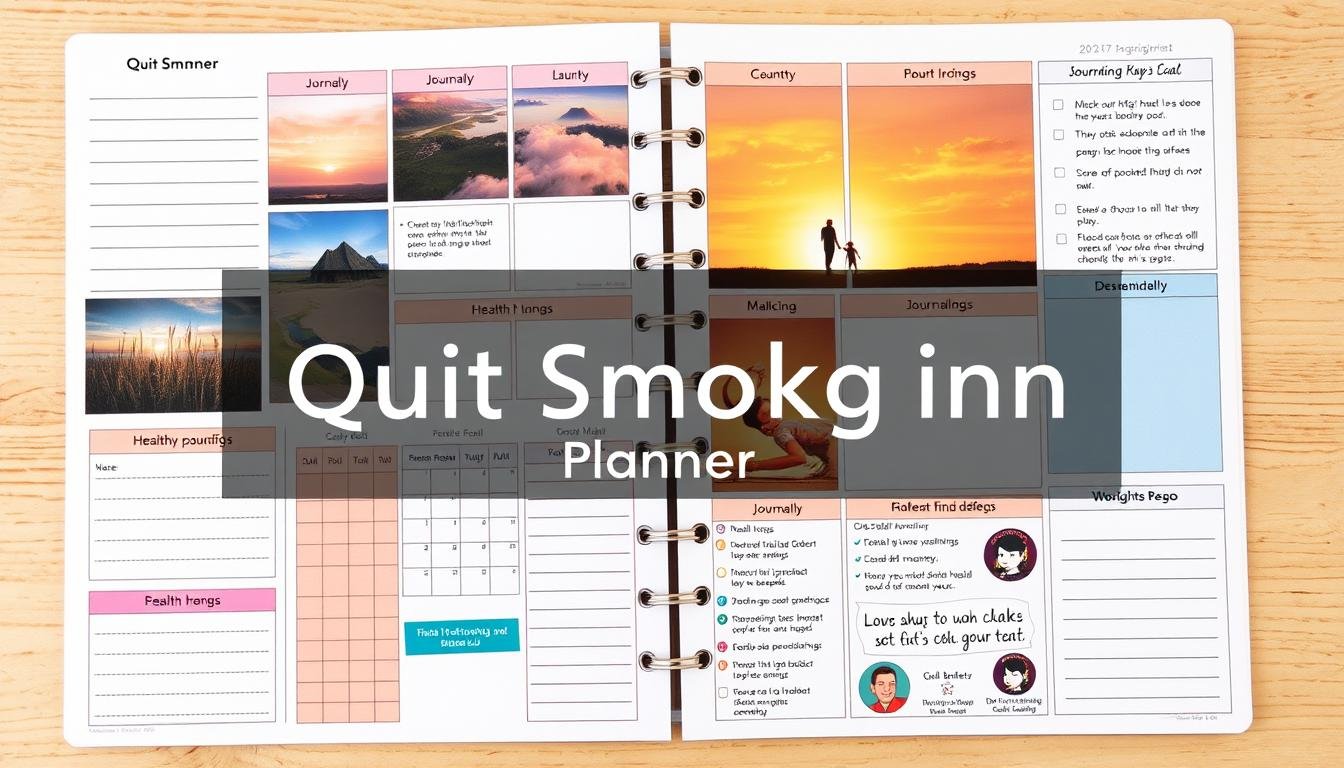Ever felt like quitting smoking is an uphill battle, especially for heavy smokers? The fight against nicotine addiction is filled with many challenges. These often leave people feeling like they can’t win.
Smoking is the top cause of preventable death in the U.S., killing over 480,000 people yearly1. It’s urgent to tackle these obstacles. Knowing about nicotine addiction, emotional barriers, and the need for a custom quit smoking plan for heavy is key to success. It’s not just about wanting to smoke; physical symptoms and social support also play big roles.
Key Takeaways
- The journey to quitting smoking is fraught with challenges.
- Understanding nicotine dependence is essential for a successful plan.
- Emotional and physical factors play significant roles in the quitting process.
- Cigarettes are the leading cause of preventable death in the U.S.
- Having social support can be critical for success.
- A well-structured quit smoking plan can increase your chances of success.
Understanding Tobacco Dependence
Tobacco dependence is a chronic condition that makes people use tobacco products despite the health risks. This strong nicotine addiction comes from how nicotine affects brain receptors. It changes how the brain works and how people behave. Knowing about tobacco dependence helps in finding ways to stop using tobacco.
Studies show that combining counseling with medication helps people quit more than just counseling alone2. Medications like nicotine patches, gums, and lozenges help manage withdrawal symptoms3. They are key in fighting tobacco use disorder.
Research also finds that quitlines and mobile apps can help people quit more often23. These tools show the need for easy-to-use support. Combining personalized counseling with medication is a strong way to treat nicotine addiction.
Health Consequences of Smoking
Tobacco use is the main cause of death worldwide. It leads to many health risks of smoking that keep growing. Smoking is linked to serious diseases like lung cancer, COPD, and heart problems. Every year, millions are urged to stop smoking to get healthier.
Tobacco Use as a Leading Cause of Death
Quitting smoking greatly lowers lung cancer risk—by 30% to 50% in ten years4. Smoking also raises heart disease and cancer risks. This shows its big role in chronic health problems5. It’s crucial to act fast to stop smoking, especially for heavy smokers.
Long-term Health Risks for Heavy Smokers
Heavy smoking’s long-term risks are huge. Even after quitting, smokers face ongoing health issues like breathing problems and heart disease4. Smoking also causes chronic diseases like emphysema and oral health issues like gum disease and tooth decay5. These facts stress the need for better ways to help people stop smoking.

| Health Effects | Short Term | Long Term |
|---|---|---|
| Increased heart rate | ✓ | ✓ |
| Bad breath and oral issues | ✓ | ✓ |
| Increased risk of respiratory infections | ✓ | ✓ |
| Lung damage and diseases | ✓ | |
| Increased cancer risk | ✓ | |
| Heart disease | ✓ |
Trying to quit smoking has big benefits. Quitting can start to reverse health problems right away. This shows why early help is key to fight tobacco’s health harms.
Emotional and Psychological Barriers
Understanding why you smoke is key to quitting. For many, certain activities or feelings make them want to smoke. Knowing these triggers helps in managing cravings and making a quit plan.
By recognizing these links, you can tackle the hidden psychological challenges of quitting.
Recognizing Triggers and Emotional Cravings
Smokers often crave cigarettes due to stress, anxiety, or being around others. Adults with depression are more likely to smoke than those without6. Knowing how these feelings and smoking are connected is crucial.
For example, people with schizophrenia smoke more than others, making quitting harder7. Spotting these cravings helps in dealing with them.
The Role of Stress and Anxiety in Smoking
Stress and smoking are closely linked. Many turn to cigarettes to handle stress and anxiety, making quitting tough. The belief that smoking relieves anxiety keeps the cycle of addiction going , reinforcing it.
Those with mental health issues often lack support in quitting, making it harder to manage stress7. Finding new ways to deal with stress can help in quitting.
Physical Hurdles in Quitting Smoking
Quitting smoking is tough, mainly because of physical dependence on nicotine. A big challenge is dealing with nicotine withdrawal. This can cause irritability, depression, and strong cravings.
Nicotine Addiction and Withdrawal Symptoms
Many struggle with severe withdrawal, making it hard to quit for good. Only 4 to 7 percent of people who try to quit without help succeed8. Most smokers start smoking again within three months8. Knowing about these symptoms can help smokers find ways to overcome them.
Impact of Weight Gain After Quitting
Another issue is weight gain after quitting smoking. Quitting can change how you eat and burn calories. This can make people worry about their health and how they look. Studies show that cravings can last for months or years, but they usually get weaker over time8.
To deal with smoking cessation challenges like weight gain, it’s important to manage weight. Adding exercise and healthy foods to your day can help avoid weight gain and keep you feeling good while quitting.

Knowing about nicotine withdrawal and weight gain can help you quit smoking better. Getting help, like medicines and therapy, is key to beating these physical barriers and living a smoke-free life can provide essential tools for managing these.
Quit Smoking Plan For Heavy Smokers
Creating a quit smoking plan for heavy smokers needs careful thought. A personalized quit plan should tackle your specific triggers, reasons for quitting, and health issues. Knowing what makes you want to smoke is key. Places where you often smoked, like parties or bars, can be tough to avoid9.
Setting a quit date is a big step. It shows you’re serious about quitting10. After picking a date, you need a plan. Use nicotine replacement like patches or gum, or try non-nicotine meds like bupropion9.
Try distracting yourself with exercise or relaxation to fight cravings. Writing down why you quit can keep you motivated. Celebrate your successes, like a week or a month without smoking, to stay on track910.
Insufficient Support Systems
Having a strong support system is key when you’re trying to quit smoking. Without social support, quitting can be much harder. Family and friends are crucial in offering encouragement and motivation.
They help create a sense of accountability and shared goals. However, many heavy smokers find it hard to get the support they need. This can make them feel isolated.
Lack of Social Support from Friends and Family
Without enough support, quitting can feel overwhelming. Studies show that those with supportive friends and family are more likely to quit. When loved ones support your goals, it boosts your motivation.
Involving your close circle can make quitting easier and increase your chances of success. Quitting without support has a 5% success rate for six months11. Getting family involved can help them think about quitting too.
Finding Professional Help and Resources
Professional help can make a big difference in quitting. Counseling for smokers is especially important for boosting success rates. Combining counseling with medication often works best12.
Resources like the tobacco quitline at 800-QUIT-NOW offer more counseling. Using nicotine replacement therapies can up your quitting chances by 50 to 70 percent13. Setting a quit date and regular check-ins with professionals can help you stay on track.

Behavioral Challenges in Quitting
Quitting smoking is tough, especially when it comes to changing your habits. Behavior modification is key to quitting smoking. It helps you create new habits and routines to replace smoking.
Adding physical activity, managing stress, and getting social support can help a lot. These steps are important for a successful quit journey.
Establishing New Habits and Routines
Creating new habits takes effort and dedication. Begin by making a list of fun activities to replace smoking. Doing these activities regularly helps stick to your quit plan.
Using behavioral strategies for smokers like setting goals and tracking progress is helpful. Find healthier alternatives to smoking to improve your health and quit efforts.
Coping with Environmental Triggers
It’s important to know what triggers your smoking. Places or situations can make you crave a cigarette. Avoiding these spots and changing your routine can help you stay quit.
Mindfulness can also help you deal with these triggers. Getting support from healthcare providers is crucial. They offer resources like counseling for nicotine addiction1415.
Strategies for Success
Quitting smoking is tough, but using the right methods can help a lot. It’s about mixing different techniques that fit your needs. The best ways include using both behavior and medicine to help you quit.
Effective Quit Smoking Techniques
There are many tips to help you quit smoking, fitting all kinds of lifestyles. Even though smoking rates have dropped, many still struggle to quit16. Smoking can cut up to 10 years off your life compared to not smoking16.
Using nicotine replacement can help. These are medicines approved by the FDA, available over the counter or by prescription. Mixing a nicotine patch with gum or lozenges can work better16. Also, medicines like bupropion and varenicline can help by reducing withdrawal symptoms and working on nicotine receptors in the brain16.
Combining Behavioral Support with Pharmacotherapy
Using both therapy and medicine together is a strong strategy. Research shows quitting doubles when you use counseling and medication together17. Therapy helps break smoking habits, and quitting improves lung function and circulation quickly17.

| Technique | Description | Benefits |
|---|---|---|
| Nicotine Replacement Therapy | Using patches, gums, and lozenges to curb cravings | Increased quit success, reduces withdrawal effects |
| Behavioral Therapy | Counseling sessions with support groups | Addresses triggers, helps establish new habits |
| Pharmacological Support | Using medications like bupropion and varenicline | Reduces withdrawal symptoms and cravings |
| Combined Methods | Utilizing both therapy and medications together | Doubles the chances of quitting successfully |
By mixing these methods and facing the challenges of quitting, you can find a way to live without smoking. Remember, it often takes more than one try to quit for good.
Smoking Cessation Resources
Getting help to quit smoking can really help. There are many resources like national quitlines and support groups. They can guide you through the tough times of quitting.
National Quitlines and Support Groups
Getting help from experts is key, especially for heavy smokers. Many groups offer great support. For example, the American Heart Association hotline (1-800-AHA-USA1) and the American Cancer Society hotline (1-800-ACS-2345) are there to help.
In the U.S., call 1-800-QUIT-NOW (1-800-784-8669) for English speakers. Canadians can reach out to Quit Now at 1-866-366-3667. These resources give you the help you need to quit smoking18.
Online Resources for Heavy Smokers
Today, online help is very important for smokers. Websites offer tools, guides, and communities to help you quit. The American Cancer Society’s guide on quitting smoking is full of useful tips to help you prepare for quitting.
Using nicotine replacement therapy (NRT) can also help. NRT comes in patches and gum. Using both types can increase your chances of quitting19. Online support can give you the motivation and tools you need to stay on track.
| Resource Type | Details |
|---|---|
| Hotline | American Heart Association: 1-800-AHA-USA1 |
| Hotline | American Cancer Society: 1-800-ACS-2345 |
| Hotline | National Quitline: 1-800-QUIT-NOW (1-800-784-8669) |
| Online Resource | American Cancer Society’s Quitting Guide |
| Online Resource | Quit Now (Canada): 1-866-366-3667 |
Overcoming Relapse
Understanding why people relapse when quitting smoking is key to success. Many heavy smokers face relapse during their journey. Knowing what causes these setbacks is vital.
Stress and triggers, like being in places where you used to smoke, can make it hard to stay quit. Studies show many people quit and relapse before they finally stay smoke-free20. The more times you try to quit, the higher your chances of success21.
Identifying Causes of Relapse
To prevent relapse, you must first know your triggers. Common ones include smoking in the car or after meals, being around smokers, drinking alcohol, and morning routines20. It’s important to learn how to handle these situations.
Knowing it might take several tries to quit for good helps keep a positive attitude. This mindset is crucial for success.
Developing a Relapse Prevention Plan
A relapse plan is about getting ready for future challenges. It involves using coping strategies, setting new quit dates, and finding support. For example, after a slip, setting a new quit date can boost your chances of success21.
Keep using nicotine replacement therapy after a slip to fight the urge to smoke20. Also, adding exercise to your daily routine can help with quitting.

By planning for challenges and staying committed, you can achieve and keep abstinence.
Success Stories and Testimonials
Real-life quit smoking success stories inspire and motivate those trying to stop smoking. Many share their struggles and how they overcame them. Lisa, for example, smoked for 45 years before quitting. She replaced smoking with 100 new activities, showing creativity can help22.
Michael’s story is a warning. He had a heart attack at 64 after smoking 40 cigarettes a day. He quit with help and has stayed smoke-free for six years. His story highlights the dangers of smoking and the need for help22.
James smoked for 15 years but quit with his partner’s support. He cut his smoking in half in five months and then quit completely. His story shows the power of support and planning in quitting22.
In the Western Pacific Region, many have quit smoking. Ho Chung Ryu from Korea quit after 36 years with help. His story is part of a larger movement to quit, as five people die from tobacco every minute23.
Amanda’s story shows how smoking affects families. She started in 5th grade and smoked heavily in college. Her smoking caused health problems for her daughter, who has allergies and asthma. Amanda’s story shows quitting can help families24.
These success stories show the many ways people quit smoking. They emphasize the role of support, determination, and personalized plans in quitting.
Best Quit Smoking Plans for Heavy Smokers
Looking for the best ways to quit smoking? A good plan for heavy smokers needs to be tailored to fit your needs. It should include support, medicine, and ways to overcome physical and emotional challenges. A solid plan should have:
Components of an Effective Quit Smoking Plan
- Psychological Counseling: Getting help from professionals can really help you quit, with a success rate of 13-17%25.
- Nicotine Replacement Therapy (NRT): Using products like patches or lozenges can help you quit with a success rate of 19-27%25. Research shows NRT can almost double your chances of quitting26.
- Combination Approaches: Mixing counseling with medicine can lead to success rates of 26-32%25.
- Support Networks: Having family or friends support you, or using quitlines, is key for staying on track26.
- Behavioral Strategies: Creating plans to handle cravings, which last about 5 to 10 minutes9, is very important.
Evaluating Different Smoking Cessation Programs
When looking at different programs to quit smoking, it’s important to find what works best for you. For heavy smokers, some programs are more effective:
| Program Type | Quit Rate | Notes |
|---|---|---|
| Self-Help Programs | 9-12% | Accessible but less effective alone. |
| Counseling | 13-17% | Increases chances of success if combined with other methods. |
| NRT (Patches, Gum) | 19-27% | Effective in reducing cravings. |
| Bupropion (Zyban) | 24% | Helpful for those with prior quit attempts. |
| Varenicline (Chantix) | 33% | Highest documented quit rate among single medications. |
| Combination Therapy | 26-36% | Best for heavy smokers facing multiple struggles. |

Using strategies tailored to your needs and understanding quit plans can greatly improve your chances of quitting. Look for programs that offer comprehensive support and resources25269.
Ongoing Maintenance After Quitting
Quitting smoking is a big win, but keeping it up needs constant effort. Getting long-term support is key to keeping this new habit. Joining support groups can boost your motivation and help you avoid going back to smoking.
Studies show that steady support helps people face challenges and stay smoke-free. It keeps them on the path to a healthier life.
Understanding the Importance of Continuous Support
Continuous support is vital for staying smoke-free. Resources from groups like the American Cancer Society can keep you motivated. Being part of a support group helps you find ways to stay smoke-free and makes lasting changes more likely.
Strategies for Long-Term Success
Effective strategies are crucial for long-term success. Here are some tips to help you stay smoke-free:
- Identify and Avoid Triggers: Know what makes you crave a cigarette and plan how to handle it.
- Engage in Physical Activity: Exercise helps with weight gain, as you might gain 5 to 10 pounds after quitting27.
- Establish New Habits: Find healthier activities to replace smoking habits.
- Practice Self-Care: Use stress management to avoid smoking when feeling anxious.
- Consider Nicotine Replacement Therapies: Products like patches or gum can help manage cravings.
- Join Organized Programs: Weight loss programs can help if you’re struggling with weight gain after quitting27.
By following these steps and staying in support groups, you boost your chances of staying smoke-free. Being proactive and adjusting your approach will help you stay committed to a healthier life.
Conclusion
Thinking about quitting smoking? It’s key to know the many ways to stop smoking. This includes mental, physical, and behavior changes. Knowing why you smoke can help you quit for good.
Many people want to quit smoking, with 68% trying to do so. Having a plan and support can really help. These things can make quitting much easier28.
Using plans from successful quit programs can help you make your own plan. Studies show that making multiple plans can lead to quitting more often. This is why planning ahead is so important29.
Getting help from friends or professionals can also keep you going. They offer the support you need to stay smoke-free.
Choosing to live without smoking is a big step towards better health. It’s a chance to feel free again. With the right strategies and support, you can achieve a healthier life. You’ll be committed to your goal every step of the way30.
FAQ
What are the biggest hurdles in a quit smoking plan for heavy smokers?
What is nicotine addiction?
How does smoking impact long-term health?
What emotional factors affect heavy smokers trying to quit?
How do stress and anxiety relate to smoking behavior?
What are the physical withdrawal symptoms when quitting smoking?
Is weight gain a concern after quitting smoking?
What components make an effective quit smoking plan for heavy smokers?
How can social support influence the quitting process?
What professional resources are available for heavy smokers?
What new habits should heavy smokers establish to replace smoking?
What role do environmental triggers play in smoking cessation?
What are some effective quit smoking techniques?
How do behavioral support and pharmacotherapy work together in quitting smoking?
What national resources exist for smoking cessation?
What online resources can help heavy smokers quit?
How can smokers identify and prevent relapse?
Why is ongoing support important after quitting smoking?
What strategies can ensure long-term success after quitting smoking?
Source Links
- https://www.uchicagomedicine.org/forefront/health-and-wellness-articles/2022/april/quitting-smoking-what-to-expect
- https://nida.nih.gov/publications/research-reports/tobacco-nicotine-e-cigarettes/what-are-treatments-tobacco-dependence
- https://www.cdc.gov/tobacco/patient-care/pdfs/hcp-conversation-guide.pdf
- https://www.cancer.gov/about-cancer/causes-prevention/risk/tobacco/quit-smoking-pdq
- https://smokefree.gov/quit-smoking/why-you-should-quit/health-effects
- https://www.mentalhealth.org.uk/explore-mental-health/a-z-topics/smoking-and-mental-health
- https://www.ncbi.nlm.nih.gov/pmc/articles/PMC6232499/
- https://www.lung.org/quit-smoking/i-want-to-quit/what-to-expect
- https://www.mayoclinic.org/healthy-lifestyle/quit-smoking/in-depth/nicotine-craving/art-20045454
- https://60plus.smokefree.gov/sites/default/files/2020-07/Print Resources_Smokefree_60plus_Quit_Plan.pdf
- https://www.aafp.org/pubs/afp/issues/2022/1100/smoking-cessation-interventions.html
- https://millionhearts.hhs.gov/files/Tobacco-Cessation-Protocol.pdf
- https://www.aafp.org/pubs/afp/issues/2012/0315/p591.html
- https://www.ncbi.nlm.nih.gov/books/NBK555596/
- https://pmc.ncbi.nlm.nih.gov/articles/PMC4562427/
- https://www.massgeneralbrigham.org/en/about/newsroom/articles/tips-to-quit-smoking
- https://www.mdanderson.org/publications/focused-on-health/6-steps-to-quit-smoking.h26Z1591413.html
- https://www.heart.org/en/healthy-living/healthy-lifestyle/quit-smoking-tobacco/help-i-want-to-quit-smoking
- https://www.cdc.gov/tobacco/about/how-to-quit.html
- https://medlineplus.gov/ency/patientinstructions/000855.htm
- https://www.nhsinform.scot/healthy-living/stopping-smoking/when-you-stop/stopping-smoking-after-a-relapse/
- https://60plus.smokefree.gov/support/stories-former-smokers
- https://www.who.int/westernpacific/news-room/feature-stories/item/be-inspired-to-quit-success-stories-from-ex-smokers-in-the-region
- https://www.cdc.gov/tobacco/campaign/tips/stories/amanda.html
- https://smokingcessationleadership.ucsf.edu/treatment-options
- https://www.cancer.org/cancer/risk-prevention/tobacco/guide-quitting-smoking/deciding-to-quit-smoking-and-making-a-plan.html
- https://medlineplus.gov/ency/patientinstructions/000811.htm
- https://www.ncbi.nlm.nih.gov/books/NBK555595/
- https://bmcpublichealth.biomedcentral.com/articles/10.1186/1471-2458-13-393
- https://pmc.ncbi.nlm.nih.gov/articles/PMC3799509/


